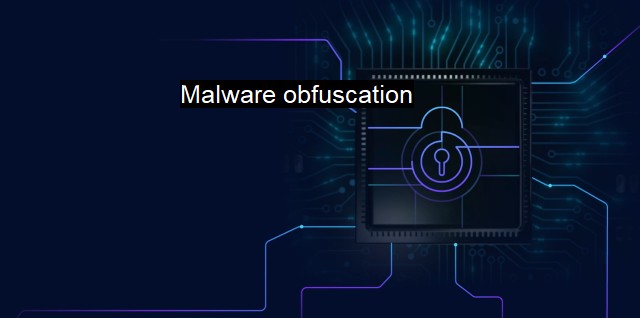What is Malware obfuscation?
Exploring the Importance of Malware Obfuscation in Modern Cybercrime
Malware obfuscation comes under the umbrella of cybersecurity - a sector that aims to protect systems, networks, and programs from potential malware attacks. In this context, malware obfuscation pertains to the methodologies used by cyber criminals to conceal their malicious software (malware) in order to avoid detection and analysis. By rendering malware indistinguishable through various techniques, attackers can insidiously invade systems, steal data, or execute illicit operations without raising the usual red flags that alert for intrusion detection.At its core, malware obfuscation capitalizes on the complex relationship between malware and antivirus software. Antivirus software, long regarded the established defense against cyber attacks and viruses, operates based on signature detection. Herein exists a loophole for potential exploitation – if malware changes beyond recognizable parameters or characteristics; that correspond to “signature identifiers,” it effectively becomes obscured beneath the undetectable veil of modification: it becomes obfuscated.
To obfuscate malware, rogue actors employ an extensive toolbelt comprising code encryption, metamorphism, polymorphism, and packing. These techniques embody the creativity and inventiveness exhibited in modern threats as attackers constantly improve upon malware obfuscation techniques, challenged by less than lucrative alterations to antivirus technologies.
Code encryption, one of the techniques used to achieve malware obfuscation, revolves around the transformation of code in a manner that makes it progressively more difficult to analyze or detect. Here, an encryption key is crucial, rendering the task of decrypting code exponentially challenging for analyzers without its leverage.
In the metamorphism technique attackers code the malware’s structure and logic into an entirely unique program during each infection cycle. Metamorphic malware evades detection because it alters its internal code while ensuring that functionality remains intact.
Meanwhile, polymorphic malware entails a process that continually rewrites itself every time it moves to a new system. The aim remains similar to metamorphism but brings the uniqueness of each mutation to a level that not even the code's internal instruction sequence maintains consistent fidelity.
Then there is packing, a rather sophisticated malware obfuscation approach that compresses bytes, making the data's investigative analysis nearly impossible without the original decompression algorithm.
Beyond these techniques, malware obfuscation also sits at the brink of AI utilization. Modern trends point towards machine learning algorithms employed to not only obfuscate malware but to adapt to the constant enhancements in the antivirus and cybersecurity fields.
What this means for cybersecurity is the increased urgency in moving beyond traditional antivirus reliance. With malware obfuscation making signature-based detection almost redundant, the reliance upon heuristics and behavioral checks has escalated. strategies capable of behavioral analysis enable the study of events within a system for suspicious patterns and prioritize real-time response over signature comparison.
The advancement in malware obfuscation presents a persistent tug of war, with each side leveraging technology to either obfuscate or detect better. Intelligence indicates an inevitable progression and sharpening of obfuscation techniques. Still, it also propounds the cybersecurity field's necessary evolution to advance in terms of sophistication, tools, skills, and strategies.
Understanding malware obfuscation and transcendence beyond antiquated antivirus software ingrains a better grasp on the true battlefield that is modern cybersecurity. Grappling with the shifting malware landscape requires not only vigilance but a conscious effort concerning emerging strategies, tactics, and tools in the open-ended game against cyber attacks. The final strategy must inherently anticipate the unexpected, adapt to the persistently mutating threats, and anchor on multi-layered defense systems capable of dealing with the highly obfuscated malware.

Malware obfuscation FAQs
What is malware obfuscation?
Malware obfuscation is a technique used by cybercriminals to alter the code of malicious software or malware to evade detection by antivirus software. Obfuscation makes it difficult for security software to identify and block malicious activity.How does malware obfuscation work?
Malware obfuscation works by obscuring the code of malware, making it difficult for antivirus software to recognize and analyze the malware. This technique may involve adding junk code, changing variable names, and modifying the structure of the code.}} {{Why do cybercriminals use malware obfuscation?}} <What can be done to prevent malware obfuscation?
To prevent malware obfuscation, it is essential to keep antivirus software and other security tools up-to-date with the latest definitions and patches. Additionally, using multi-layered security, including firewalls, intrusion detection systems, and secure browsing practices, can help prevent malware infections.| | A | | | B | | | C | | | D | | | E | | | F | | | G | | | H | | | I | | | J | | | K | | | L | | | M | |
| | N | | | O | | | P | | | Q | | | R | | | S | | | T | | | U | | | V | | | W | | | X | | | Y | | | Z | |
| | 1 | | | 2 | | | 3 | | | 4 | | | 7 | | | 8 | | |||||||